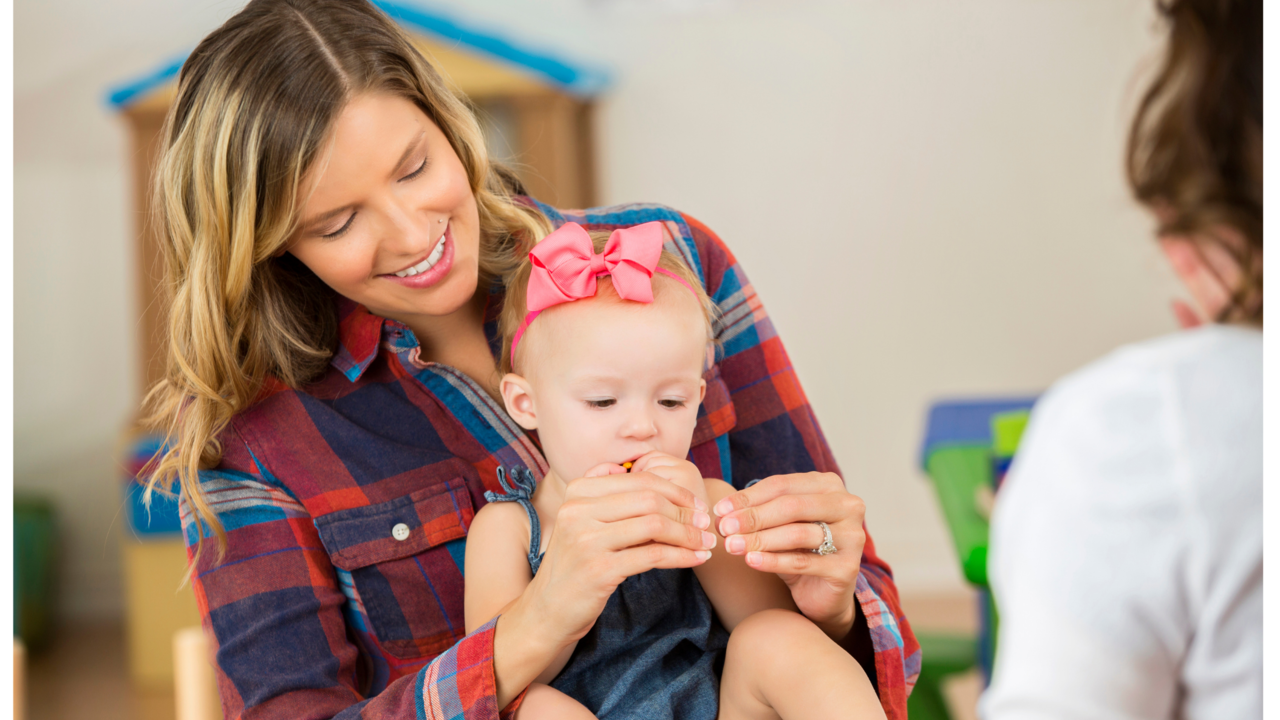Baby Sign Language? Yes Please! The early signs I taught my toddlers and why

Baby sign language is something you might be considering doing with your toddler who is a late talker, or you might just want to teach your child signs like how to sign please, all done, milk before they are able to say those words.
When my kids were babies, I taught all of them a few signs that really helped them before they could communicate verbally. Although my first and my third born were early talkers, I still used signs with them before they were able to use a variety of words consistently. It was especially helpful for my middle child, who was a late talker. It was so rewarding for him (and me!) when he was able to clearly communicate what he wanted, even before he could say the words.
As a SLP and mom, I knew that using signs actually HELPS kids learn and develop language and eventually use words and talk! That is…. if the signs are introduced and used appropriately.
So, before we go over the signs, let’s go over HOW to introduce, teach, and use them.
SAY THE WORD AND SIGN TOGETHER
It is important that as you introduce signs, you are always using the verbal production as well as the sign - SAY the word as you sign. This is important, because if the goal for your child is verbal speech, you always need to pair the sign with the word, so your child learns the meaning of the word, sees the sign, and hears the model of the word over and over.
USE SIGNS IN CONTEXT
When you are teaching your child signs, you will be modeling the signs IN CONTEXT for your child. You always need to be using the sign when it makes sense and during a situation your child would actually want or need to communicate whatever the sign is. You don’t want to just be randomly modeling signs for your child at any time of day when it’s not even relevant. This will make it difficult for your child to understand the meaning of the sign. Make sure you always use the sign when appropriate and when it would be meaningful and provide a WANT or a NEED for your child.
DON'T EXPECT THEM TO SIGN TOO SOON
Make sure you aren’t expecting your child to sign before he/she is ready. I know you are motivated and excited to get your child to communicate, but don’t withhold items until he signs, or not do whatever he is asking you to do until he signs, or you will only be creating more frustration for your child.
So what should you do??
Just model the sign, say the word, and do whatever is being communicated with the sign right after you model it. Remember - as long as your child is hearing and watching, they are learning from your model, even if they don't actually do the sign or say the word.
ACCEPT ANY ATTEMPT YOUR CHILD MAKES AT THE SIGN
When your child is first learning signs (just like when they first learn to talk), they might not do the sign exactly as you do. When learning to talk, your child might say words differently than the adult production at first (which is totally normal by the way!) Example- your child might say “poon” for ‘spoon’ when first learning to talk.
So, with signs, your child might be trying to sign - which, remember - is your child trying to communicate with you!! So, accept any attempt at the sign that your child makes and remember to always MODEL the sign so they can continue learning how to use and produce the sign.
Make sure when your child first starts using signs, that you respond right away to the communication attempt. You want your child to have many, many, successful communication attempts. So, make sure to set your child up for success by responding right away and making it fun when your child tries to communicate with you!
Now that you know more about how to introduce, teach, and the appropriate way to use signs with your child, here are the signs I taught my own kids when they were little. These are great signs to start with to teach your child when still learning to talk. These are also great for toddlers who are late talkers!
MORE
This sign is done by putting your fingers and thumbs together and touching the tips of your fingers to each other.

This is probably the number one sign I recommend and also the sign I recommend parents teach first to their child. This is the first sign my kids learned and I used it a lot during mealtimes.
They had so much fun using this sign, because it was so effective! There are going to be times where your child signs ‘more’ but you might not want to give them more, and that’s ok! You are the parent! Just make sure you still respond to their communication request, but it’s ok to say ‘no’, just like you will later on when they are talking :)
If you haven’t taught your toddler this sign yet, you need to right now!! Especially if your toddler is struggling to talk and does not have very many words yet or is difficult to understand.
It is so motivating for your child to be able to communicate in a way that causes something to happen (your child signs, and then makes something happen). They sign ‘more’ and you give…. more food, more playing, more tickling, more music…. There are so many fun ways to use this sign!
This is a really great sign to use when your child is eating. Try modeling it at first, when your child looks like they want more of a snack. For example, look at your child, get their attention and model the sign ‘more’ while you ask your child “Want more?” Don’t worry if your child doesn’t do the sign at first. Over time, your child will learn it if you model it consistently.
HELP
This sign is done by placing one hand flat and facing up, then the other hand on top of that hand in a fist, with your thumb up.

This is a sign that I taught my kids to reduce their level of frustration. If they needed help with something, they were able to communicate it by signing, rather than just crying or yelling in frustration… although of course they still had their crying and yelling moments, but signs were a huge help!!
If you see your child struggling to do something, before you jump right in, take a second to pause, model the sign and ask your child, “Do you need help?” as you sign the word.
ALL DONE
This sign is done by holding your hands up with your elbows bent at your side. Then, turn your palms to face you and then flip your hands over so your palms face outward.

This was another one I used with my kids a lot during mealtimes. It was great for them to be able to communicate to me when they were all done! They loved having that ‘power’ of communication before they could actually say those words.
Again, if they are signing ‘all done’, but you aren’t quite ready for them to be done, it’s ok to say no, but please make sure you always acknowledge their communication attempts! You could say, “Oops! We’re not all done yet…. First let’s do_____, then you’ll be all done!”
MILK
This sign is done with one hand held up in a fist. Then, you open and close your fist several times.

This was a powerful sign for my kids. I breastfed all 3 of them and they all learned and loved to use this sign. It was also super helpful because if they were crying and I wasn’t sure why, they could tell me if they were hungry by signing “milk”. Or… if they were crying and I didn’t know what was wrong, I could sign to them, “Milk?” and they would either shake their head no, or get ready to breastfeed. Once they were consistent in using this sign, I knew that if they were crying and NOT signing milk, they were probably crying for another reason.
Of course, you don’t have to be breastfeeding to use this sign. You can use this sign to indicate they want their bottle/formula, sippy cup with milk, etc..
PLEASE
This sign is done by placing one palm on your chest and moving it in a circle.

I usually introduced this sign a little later, as it’s not as necessary or as urgent as the other signs. However, my kids ended up using it as more of “I want”, as they would indicate “please” when they wanted something. Hey, at least they’re learning to ask politely for things!
As long as you and your child know what the sign means, it can work really well for both of you!
Feel free to use this with your child before giving them something they want. Remember to model the sign, say it, and then give your child what they want, until they learn it. After that, you can pause and give your child time to use the sign “please” before giving something. If they forget, no worries! Just jump in there and model the sign, say the word, and give your child the item they wants.
Remember to keep modeling the signs (always along with words) in context and your child will catch on! Have fun with signing and use it in everyday routines (when relevant & in context) and also make sure to include signs during fun playtime!
See free downloadable pdf with pictures of signs and tips on teaching signs.

